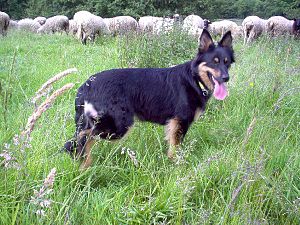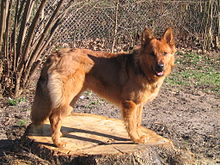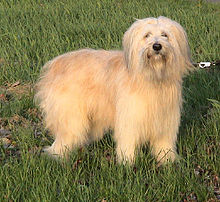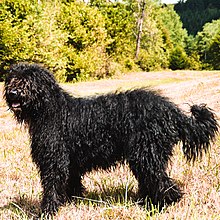Old German herding dogs
| Old German herding dogs | |||
|---|---|---|---|
|
|||
| Not from the FCI recognized | |||
| Origin : | |||
| Varieties : |
Yellow cheek |
||
| List of domestic dogs | |||
Old German herding dogs are herding dogs from Germany that are threatened with extinction . These dogs were kept almost exclusively by wandering shepherds. Their appearance is very different, as their usability and performance were in the foreground.
Appearance and essential characteristics
The current name Altdeutsche Hütehunde is a generic term for different strokes with different looks and different characteristics. From the Middle Ages, traveling sheep farming spread across Europe. The shepherds brought dogs with them to protect the herd, to drive and guard them. These shepherd dogs in what is now Germany's territory were mostly of medium size, light and agile and had a weatherproof coat. Over the centuries, the shepherds ' selection , which primarily focused on usability with regard to the type of cattle to be herded, resulted in different regional varieties. Some names of the blows indicate this: For example, one speaks of the Harz fox , the Westerwald cow dog and the Pomeranian poodle .
This use-related type of selection took place long before the emergence of breed associations towards the end of the 19th century. The term breed is still rejected for these dogs today, as there is basically no selection based on external characteristics.
However, due to the considerable decline in the population of most of the old Germans, the goal of preserving these fields has often come first. In this respect, it cannot be dismissed out of hand that, ultimately, breeding based on external characteristics is also practiced. Whether other goals, such as better suitability for keeping away from pasture farming, should also be added for the purpose of preserving these animals is controversial.
The essential characteristics of all strokes include easy handling, hardness, heat resistance and endurance. In terms of character, the old German herding dogs correspond to the requirements of a typical working dog. You are spirited, daring, willing to work and very independent.
Conservation efforts
Working group for the breeding of old German herding dogs
Since traveling sheep is practically non-existent, these hats are threatened with extinction.
With the help of KH Finger, thirty shepherds founded the Working Group for Breeding Old German Herding Dogs (AAH) in 1989. The aim of the AAH is to record and preserve the still existing beats of the old German herding dogs. Supported by the geneticist Dres. Beuing, a stud book has been kept at TG-Verlag in Gießen since 1990, in which the offspring of all lofts of the old German herding dogs are registered.
Classification of strokes
The different varieties are mainly divided as follows: On the first level according to the cattle that are being looked after, i.e. into cow dogs and sheep dogs. Then according to the distribution area and the appearance in the East or Middle German type , the South German type and the Zotthaarigen type . On a third level, a distinction is made between the colors.
-
Cow dogs (1st level)
- Westerwald
- Winning countries
- Sheepdogs (1st level)
- South German type (2nd level)
- South German yellow cheek (3rd level)
- South German black
- tiger
- East or Central German type (2nd level)
- East or Central German Yellow Cheeks (3rd level)
- East or central German black
- East or central German fox
- Harzer Fuchs (which is a peculiarity because it was originally a cow dog, which over time has become part of the red sheep dogs; as a regional variant of the fox, it is classified here in the 4th level .)
- Shaggy-haired type (2nd level)
- South German type (2nd level)
In the case of the East or Central German Old German , also known under the traditional name Old German Shepherd , there is no subdivision into colors such as yellow cheek, black and fox (but not Harz fox). They are considered a common loft and can be paired with each other. Other colors of the East and Central Germans are wild and white; however, they are very rare chance results in breeding. The white color is considered to be extinct.
The listed blows are not an exhaustive list; For example, due to deeper regional subdivisions, such as for the Harzer Fuchs, further classifications can be made. In southern Germany a distinction was made between the roll-haired old German , which is now so rare that it was no longer shown separately in a survey by the GEH from 2001 because it was "almost no longer available"; a few remaining copies may still be in Baden-Württemberg. In other strokes, curly hairiness can occasionally appear.
Dogs with a congenital stump tail are called stumpers ; they can appear in all beats.
Red List of the Society for the Conservation of Ancient and Endangered Breeds of Domestic Animals
The Society for the Preservation of Old and Endangered Pet Breeds eV (GEH) lists old German herding dogs as endangered breeds. It leads them in the red list according to the degree of endangerment in
- Category I (extremely endangered): Westerwald cow dog (30-40 pure-bred specimens survived in 2006)
- Category II (endangered): sheep poodle (also known as herding poodle)
- Category III (endangered): yellow cheek, black, fox, tiger, strobel
The old German herding dog was declared "Endangered Livestock Breed of the Year" by the Society for the Preservation of Old and Endangered Domestic Breeds (GEH) in 1998 together with the white horned heather.
See also
literature
- Gabriele Lehari: Ulmer's large lexicon of dog breeds. Eugen Ulmer Verlag, Stuttgart 2004, ISBN 3-8001-4614-2 .
- Rudolf Löns: The German Shepherd Dogs. A handbook. Creutz'sche Verlagsbuchhandlung, Magdeburg 1924.
- Max von Stephanitz : The German Shepherd Dog in words and pictures. 6th, completely revised and greatly increased edition. Association for German Shepherds, Munich 1921, online .
- Richard Strebel : The German dogs and their descent. With consultation and discussion of all dog breeds. 2 volumes. Ertel, Munich 1903–1905 (1st edition, anniversary edition for the 125th birthday of Richard Strebel, reprint of the first edition 1904/1905. 2 volumes. Kynos Verlag , Mürlenbach 1986, ISBN 3-924008-08-6 ).
Web links
- Working group for the breeding of old German herding dogs
- Interest group of old German herding dogs
- Old German herding dogs through the ages
Individual evidence
- ↑ aah.org: Top 10 questions: 2. Why does the AAH not seek FCI recognition for their strokes?
- ↑ aah.org: Top 10 questions: 10. Are the old Germans suitable as family dogs?
- ^ Description of the IG Altdeutsche Hütehunde
- ↑ Description of the old German herding dogs by the old German herding dog interest group
- ↑ Description of the Central German / East German Yellow Cheeks by the AAH
- ↑ Illustrated description of wild-colored and white East and Central Germans by the IG Altdeutsche Hütehunde
- ↑ Description of the Rollhaarigen Altdeutschen ( Memento from September 24, 2015 in the Internet Archive ) from the GEH online brochure Endangered Livestock Breeds, 2008 (PDF; 306 kB)
- ↑ Christel Simantke: What kind of pinscher is that? (PDF; 212 kB) in Arche Nova 3/2001, 12, 13, p. 12 (see table)
- ↑ Description of the old German herding dog by the GEH






